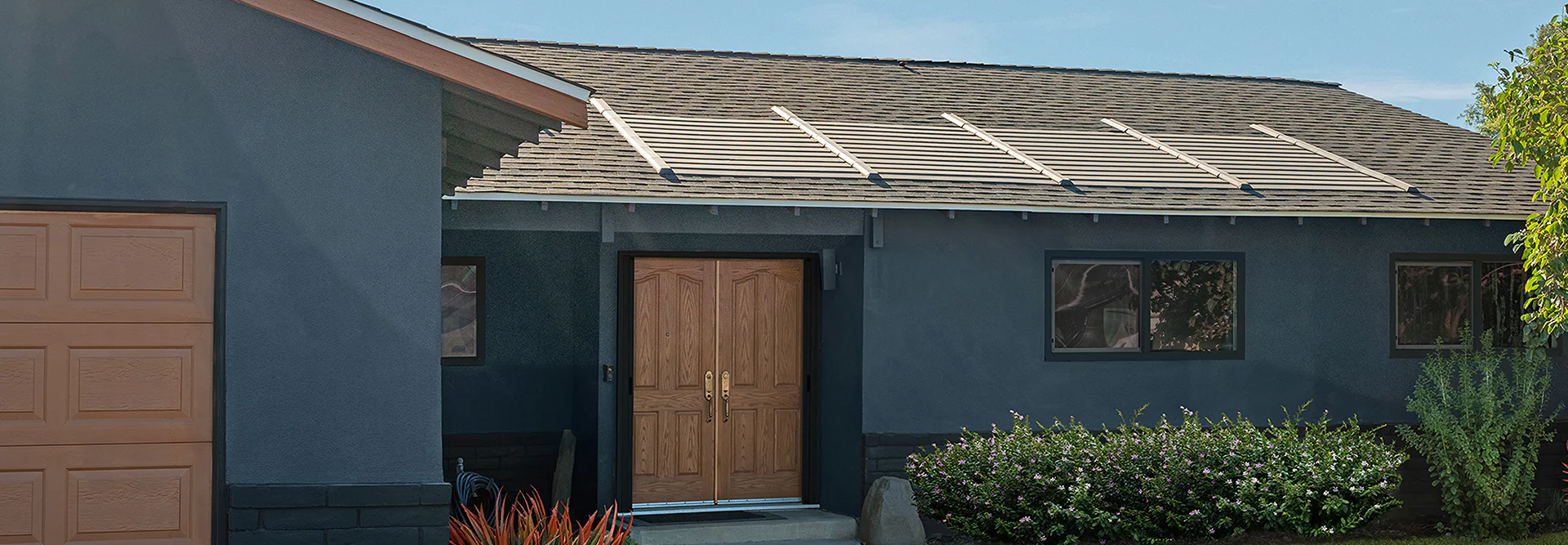Solar shingles represent a significant shift in how homeowners approach energy independence and roof replacement decisions. Unlike traditional approaches that separate roofing and energy generation into distinct projects, this technology integrates both functions into a single, comprehensive home improvement investment.
The cost considerations extend far beyond simple product pricing, involving multiple factors that can dramatically influence your total investment and long-term returns. From roof characteristics and energy requirements to regional variations and available incentives, understanding these variables helps homeowners make informed decisions about this emerging technology.
Here we will break down the essential cost factors, installation considerations, and practical requirements to help you determine whether solar shingles align with your home’s needs and budget. By examining the complete financial picture, you can evaluate this innovative roofing solution and make the choice that best serves your long-term goals.
Benefits of Solar Shingles
Residential solar roofing systems have come a long way from the clunky, experimental products of the past. GAF Timberline Solar ES 2 shingles represent what homeowners have been waiting for—solar power that doesn’t scream “I have solar panels” from the street. These aren’t your typical bolt-on solar panels that sit awkwardly on top of your roof. Instead, they replace your actual shingles, becoming part of your roof itself.
What makes these different is the power output. Each shingle now produces 57 watts, which is a significant jump from earlier versions. That means you need fewer of them to generate the same amount of electricity, and honestly, that’s a game-changer for both aesthetics and cost. Plus, they’re tough enough to handle 130 mph winds—they’re actually the only solar shingles approved for Miami-Dade County’s hurricane requirements, which are notoriously strict.
The warranty situation is solid too. You get 25 years on the product itself, 15 years for wind damage, and 25 years on power output—basically the same coverage you’d expect from high-end traditional solar panels. Yes, you’ll pay more upfront than regular shingles, but between the energy savings and various tax incentives, most homeowners see the math work out favorably over time. The real bonus? Your home value goes up, and you’re generating your own power.
The Costs of Solar Shingles
Here’s what makes solar shingles different: they require a complete roof replacement, which means removing your existing shingles entirely. Rather than seeing this as a drawback, smart homeowners recognize this as getting two major home improvements in one project. You’re not just adding solar—you’re getting a brand-new roof that happens to generate electricity.
When you break down the numbers, a quality roof replacement typically costs $15,000 to $25,000 anyway. That means you’re paying an additional $20,000 to $50,000 to transform your roof into a power-generating asset. Compare that to installing traditional panels on an aging roof that you’ll need to replace in a few years, and suddenly you’re looking at two separate projects with double the disruption.
The financial benefits add up quickly. Federal tax credits knock 30% off your investment immediately, and many states offer additional incentives. Most homeowners see payback within 10 to 20 years, but you’re also adding significant value to your home while eliminating monthly electric bills.
The real advantage? You’re future-proofing your home with cutting-edge technology that looks like a premium roof, not a science experiment. When your neighbors are dealing with roof replacements and mounting solar panels separately, you’ve already handled both with one elegant solution that will serve your home for decades.
Factors Influencing Solar Shingle Costs
Several key factors determine the final price of your solar shingle investment, and understanding these variables helps you plan your budget more effectively.
Roof Size and Complexity
The square footage of your roof directly impacts costs, but it’s not just about total area. Complex rooflines with multiple angles, dormers, chimneys, or skylights require more precision work and specialized cutting, which increases material waste and labor time. Simple, straightforward roof designs typically offer the most cost-effective solar shingle projects.
Energy Requirements
Your home’s electricity consumption determines how much of your roof needs solar coverage. Homes with higher energy demands require more solar shingles, driving up costs. However, you don’t always need to cover your entire roof—strategic placement on south-facing sections can often meet most of your energy needs at a lower cost.
Geographic Location
Regional factors significantly affect pricing. Areas with high electricity rates see faster payback periods, making premium solar shingles more attractive. Local building codes, permit requirements, and available rebates also vary by location. Additionally, regions with more solar-friendly policies often have more competitive pricing due to increased market activity.
System Components
Beyond the shingles themselves, costs include inverters, electrical connections, monitoring systems, and necessary permits. Higher-quality inverters and advanced monitoring capabilities increase upfront costs but often provide better long-term performance and easier maintenance.
Seasonal Timing
Like most home improvement projects, solar shingle costs can fluctuate seasonally. Off-peak seasons may offer better pricing on materials and more flexible scheduling, while peak demand periods typically command premium pricing.
Solar Shingle Installation Costs
Professional crews experienced in solar shingle technology typically charge premium rates, but this expertise proves essential for optimal system performance. Complex rooflines with multiple angles, chimneys, or architectural features require more skilled work and time, naturally increasing labor costs. Geographic location also plays a role, as regions with higher living costs and limited experienced contractors command higher rates.
Permitting and inspection fees add another layer to project expenses, typically ranging from $500 to $1,500 depending on local municipality requirements. Some areas have streamlined solar permitting processes, while others require extensive documentation and multiple inspection phases. These regulatory costs, though often overlooked in initial estimates, represent necessary investments in ensuring your system meets all safety and performance standards.
Additional project expenses may include electrical upgrades to accommodate your new solar system, temporary housing arrangements if extensive work is required, and potential structural modifications to support the integrated technology. Smart homeowners budget an additional 10-15% beyond quoted prices to account for unexpected discoveries or upgrade opportunities that emerge during the project.
Are Solar Shingles Right for Your Home & How Many do You Need?
Not every home is an ideal candidate for solar shingles, and the decision depends heavily on your roof’s current condition and timing. Solar shingles make the most financial sense when your roof already needs replacement within the next few years. If your current roof has a decade or more of life left, traditional solar panels mounted on top might be more cost-effective. The sweet spot for solar shingles is when you’re facing an inevitable roof replacement and want to combine both projects into one comprehensive upgrade.
Your home’s sun exposure and energy consumption patterns determine both suitability and quantity needed. South-facing roofs perform best, though east and west-facing orientations also work well with optimal roof angles between 30-50 degrees. Heavily shaded properties may not generate enough electricity to justify the investment. To calculate how many solar shingles you need, examine your annual electricity bills to understand your usage patterns, then factor in your roof’s available solar-suitable square footage. Solar shingle systems typically use a mix of active solar shingles and inactive shingles to maximize coverage and power output based on your specific energy needs.
FAQ’s: Solar Shingle Costs
Our most frequently asked questions when talking to homeowners about the costs of solar shingles:
How much do solar shingles cost compared to traditional panels?
Solar shingles typically cost more upfront than traditional solar panels, but the comparison isn’t entirely fair since you’re getting two major home improvements in one project. While traditional panels require mounting on your existing roof, solar shingles like GAF’s system replace a portion of your roof while generating electricity, essentially combining roofing and solar costs into a single investment.
Are solar shingles a worthwhile investment?
Solar shingles make sense if you’re already planning a roof replacement and want the clean look without bulky panels sitting on top. You’re basically getting a new roof that happens to generate electricity, which adds serious value to your home while cutting your monthly electric bills. The upfront cost is higher, but when you factor in tax credits and the fact that you’re handling two major projects at once, most homeowners find the investment worthwhile.
Discover Solar Shingles with DaBella
Ready to transform your roof into a power-generating asset? As a GAF Master Elite contractor, DaBella specializes in GAF Timberline Solar ES 2 shingles that deliver both premium roofing protection and clean energy production. These innovative shingles integrate seamlessly into your roofline, creating an attractive, cohesive appearance while generating electricity to reduce your monthly utility bills.
Our solar shingles represent more than just an energy solution—they’re a smart investment in your home’s future. With GAF’s industry-leading warranties backing every installation, you can trust that your solar roofing system will perform reliably for decades. The advanced photovoltaic technology efficiently converts sunlight into usable electricity while maintaining the durability and weather resistance you expect from premium roofing materials.
Our team takes time to explain how solar shingles work, their long-term financial benefits, and how they fit within your specific budget and energy goals. We’re not just installing a product—we’re helping you create a more sustainable, valuable, and energy-independent home.
Take the first step toward energy independence and increased home value. Contact DaBella today at 844-DaBella to schedule your free consultation. Our solar roofing experts are ready to assess your home’s potential and design a custom solution that meets your energy needs while enhancing your property’s appeal and performance.

